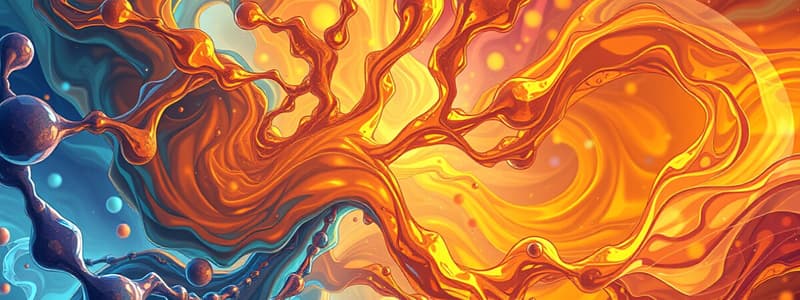Podcast
Questions and Answers
What is the main type of change associated with an exothermic process?
What is the main type of change associated with an exothermic process?
- Temperature remains constant
- Energy is released (correct)
- Energy is absorbed
- No energy change occurs
Diffusion occurs only in gases.
Diffusion occurs only in gases.
False (B)
What is bond energy?
What is bond energy?
Energy required to break or form one mole of a covalent bond.
In an endothermic change, energy is ______.
In an endothermic change, energy is ______.
Match the following concepts related to changes in energy:
Match the following concepts related to changes in energy:
Flashcards are hidden until you start studying
Study Notes
Diffusion
- Movement of particles from high concentration to low concentration until equilibrium is achieved.
- Particles exhibit constant random motion.
- Diffusion occurs in liquids.
Factors Affecting
Exothermic vs. Endothermic
- Exothermic: Energy is released during the process (e.g., combustion, respiration, rusting).
- Endothermic: Energy is absorbed during the process (e.g., reversing sublimation, melting).
Physical Changes
- Exothermic examples: condensation, freezing, and sublimation.
- Endothermic examples: boiling/evaporation, dissolving salts.
Chemical Changes
- Exothermic reactions include acid + metal and thermal decomposition.
- Endothermic processes include electrolysis, photosynthesis, and digestion.
Energy Bond Forming
- Energy level diagram illustrates the energy changes during reactions.
- ΔH value indicates the change in enthalpy.
Bond Energy
- Energy needed to break or form one mole of a covalent bond.
Calculation on Energy Changes
- Steps to calculate energy changes include:
- Balancing the chemical equation.
- Drawing molecular structures or structural formula.
- Identifying reactants and products.
Factors Affecting Rate of Reaction (R.O.R)
- Concentration: Higher concentration increases reaction rate.
- Surface Area: Increased surface area enhances collision frequency.
- Temperature: Rising temperature increases kinetic energy and reaction rate.
- Catalyst: Speeds up reaction without being consumed.
- Pressure: Increased pressure affects reactions involving gases.
- Light: Presence of light can influence certain chemical reactions.
Experimental Techniques
- Change in mass: A method to monitor the rate of reaction.
- Rate: Measurement of how quickly reactants convert to products.
Studying That Suits You
Use AI to generate personalized quizzes and flashcards to suit your learning preferences.




